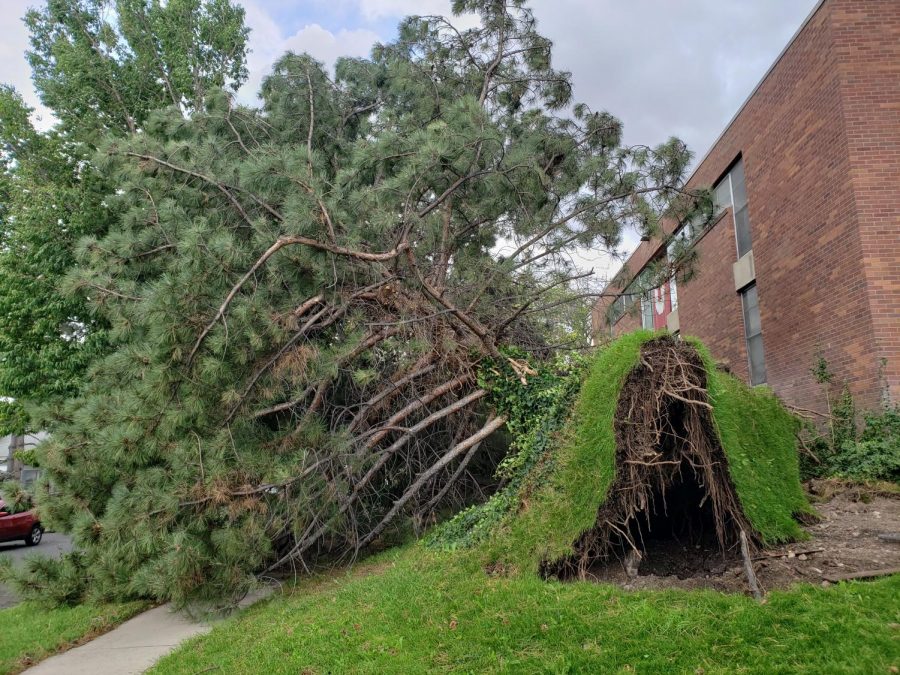September Wind Storm in SLC Continues to Impact U Students
October 25, 2020
On Sept. 7, the greater Salt Lake area and surrounding cities experienced irregular winds from 40 to 70 miles per hour. The University of Utah reported gusts upwards of 100 miles per hour, placing the storm in categories used to classify tornadoes and hurricanes. It is reported that over 180,000 customers lost power on Tuesday, Sept. 8. Rocky Mountain Power and Comcast services reported outages for several days, ranging from 3 to 8 days. Some Comcast customers were without internet for almost 10 days.
“My house was out of power for four days and that kinda sucked, then also my work was out of power for two days,” said Abi Huber, a student studying information systems.
The U canceled classes on Sept. 8, and some professors extended due dates for assignments during that time, but this set students back with course material. Being four weeks into the semester, many students had their first exams closely approaching. The loss of power and the internet hindered some students’ studies, as they struggled to access the material.
Students on Twitter criticized the university’s decision to have classes the next day, saying they were disregarding student needs.
“Breaking news: the U of U once again, does not consult the student body on a decision that directly impacts their education and wellbeing,” user @ramentobi said in a tweet.
Victor Vinh Ha, a student in the U college of pharmacy, said the lack of access to WiFi hurt his academic capabilities.
“I really need to access WiFi because the recordings are not downloadable,” Vinh Ha said.
“After the wind storm hit on Tuesday all the power in my apartment went out and not only was I not able to attend the zoom lecture but I also wasn’t able to even access the lectures later. I had two exams this week, and the first one I did pretty decently, but the second one I completely bombed. I think it’s probably because the power and WiFi were still out.”
Many students like Vinh Ha visited places nearby like cafe’s, restaurants, grocery stores, and malls to use the free wifi they offer, which wasn’t always available when needed. Vinh Ha ended up staying at a fellow student’s place and a nearby hotel for power and wifi so he could study, and he wasn’t the only student in search of a place to study.
“There’s a lot more distractions from taking over someone else’s space. I know that classes still had to go on. They couldn’t just cancel school for three days and be so behind in the semester but on the flip side, your routine being thrown off like that definitely sets you back studying wise, especially in some difficult classes with exams coming up. But I feel like my professors were for the most part very understandable,” said Joseph Rapp, a College of Pharmacy student.
Winds of this caliber haven’t been recorded in the area since the wind storm in December 2011, and the damage has taken unexpected time and money to recover.
“We estimate 3,000 city trees were damaged or came down completely. For perspective, the city manages 86,000 street, park, golf course, and other public trees in the urban forest. We estimate more than 7,000 tons of woody debris have been removed so far. The extent of the damage in Salt Lake, Davis, and Weber counties is estimated to exceed $10 million; total costs will not be known for some time,” said Lorna Vogt, Director of Salt Lake City Department of Public Services.
The Salt Lake City Emergency Operation Center organized clean up for the city, utilizing city and state departments in Public Services, 200+ city employees, volunteers, the National Guard, UDOT, private arborists, the SLC street division, and 17 other agencies under the Mutual Aid Agreement, and more. There was even an emergency shelter available for one night. The city completed two rounds of cleanup of garbage and debris collection, as well as street sweeping.
“The city responded to all city-owned trees and property, damaged sidewalks, streetlights, and other infrastructure. Most of the work was in the public right-of-way, parks, and the Cemetery.” Vogt said, who served as the Incident Commander with the assistance of the Emergency Management Division.
Volunteers and neighbors came together to help with cleanup in neighborhoods with privately-owned trees, which were then picked up off the curb during the two rounds of collection. The city is in a race with the weather to finish large stump removal and city infrastructure repair.
“Residents have been asked to contact Waste and Recycling for residual private debris that was collected after the city completed the two rounds of street cleanup,” Vogt said.
To contact Salt Lake City Waste and Recycling, click here or email them.







